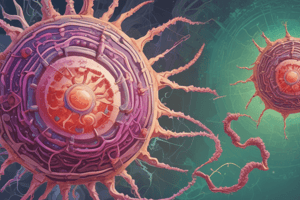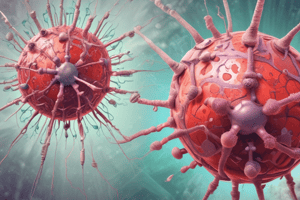Podcast
Questions and Answers
What is the primary mechanism by which Varicella-Zoster Virus (VZV) establishes latency within the human body?
What is the primary mechanism by which Varicella-Zoster Virus (VZV) establishes latency within the human body?
- Establishment within sensory neurons followed by retrograde axonal transport to dorsal root ganglia. (correct)
- Circulation within the bloodstream and temporary sequestration in liver cells.
- Integration of the viral DNA into the host cell's genome within the respiratory tract mucosa.
- Direct infection and subsequent dormancy within the epithelial cells of the skin.
Why is acyclovir, famciclovir, and valacyclovir recommended for adults with VZV, while often not needed for children?
Why is acyclovir, famciclovir, and valacyclovir recommended for adults with VZV, while often not needed for children?
- VZV presents more severely in adults, necessitating antiviral intervention to mitigate complications. (correct)
- Children typically have pre-existing immunity that negates the need for antiviral treatment.
- Children are more likely to develop resistance to antiviral medications, making treatment counterproductive.
- Antiviral medications are ineffective in children due to differences in viral replication cycles.
A clinician suspects a patient has a VZV infection. What diagnostic method offers the highest sensitivity for confirming the presence of VZV in skin lesions?
A clinician suspects a patient has a VZV infection. What diagnostic method offers the highest sensitivity for confirming the presence of VZV in skin lesions?
- Direct fluorescent antibody to membrane antigen (FAMA) assay.
- Tzanck smear to identify multinucleated giant cells.
- IgM serologic testing to detect acute infection.
- PCR assay to detect VZV DNA. (correct)
Why does post-herpetic neuralgia occur following a shingles outbreak, and what underlies the long-lasting pain?
Why does post-herpetic neuralgia occur following a shingles outbreak, and what underlies the long-lasting pain?
What immunological factor is most critical in preventing the reactivation of VZV from its latent state?
What immunological factor is most critical in preventing the reactivation of VZV from its latent state?
What is the rationale behind administering varicella-zoster immune globulin (VZIG) to immunocompromised individuals after exposure to VZV?
What is the rationale behind administering varicella-zoster immune globulin (VZIG) to immunocompromised individuals after exposure to VZV?
Why is aspirin contraindicated in children with VZV infection?
Why is aspirin contraindicated in children with VZV infection?
How does the VZV vaccine work to prevent varicella, and what type of immunity does it primarily induce?
How does the VZV vaccine work to prevent varicella, and what type of immunity does it primarily induce?
While VZV is known to be neurotropic, what is the initial site of infection in the body following exposure?
While VZV is known to be neurotropic, what is the initial site of infection in the body following exposure?
How does the appearance of the rash in varicella (chickenpox) typically progress, and what is a key characteristic feature of this progression?
How does the appearance of the rash in varicella (chickenpox) typically progress, and what is a key characteristic feature of this progression?
Flashcards
VZV Transmission
VZV Transmission
Transmission occurs through respiratory droplets and direct contact. Common and highly contagious in childhood, with most U.S. adults having antibodies.
VZV Pathogenesis
VZV Pathogenesis
After infecting the respiratory tract, VZV spreads to the skin causing a rash, then travels to sensory neurons, becoming latent in dorsal root ganglia. Reactivation causes shingles.
Varicella Symptoms
Varicella Symptoms
Incubation of 14-21 days, prodromal symptoms (fever, malaise), papulovesicular rash on the trunk spreading outwards that evolves into crusts. Itching is very common. More severe in adults.
Zoster Symptoms
Zoster Symptoms
Signup and view all the flashcards
VZV Diagnosis
VZV Diagnosis
Signup and view all the flashcards
VZV Treatment
VZV Treatment
Signup and view all the flashcards
VZV Characteristics
VZV Characteristics
Signup and view all the flashcards
Varicella Complications
Varicella Complications
Signup and view all the flashcards
Study Notes
- Varicella-Zoster Virus (VZV) transmits through respiratory droplets and direct contact with lesions.
- VZV is a highly contagious childhood disease occurring worldwide.
- Over 90% of individuals in the U.S. have VZV antibodies by age 10.
- VZV initially infects the mucosa of the upper respiratory tract.
- The virus spreads through the blood to the skin, causing a papulovesicular rash.
- VZV infects sensory neurons, traveling by retrograde axonal flow to dorsal root ganglia cells.
- In dorsal root ganglia cells, the virus becomes latent.
- Reactivation occurs when cell-mediated immunity is reduced or local trauma occurs.
- Reactivation causes vesicular skin lesions and nerve pain characteristic of Zoster.
Varicella
- Incubation period is 14-21 days.
- Prodromal symptoms include fever and malaise.
- Rash appears in crops on the trunk, spreading to the head and extremities.
- Rash evolves from papules to vesicles, pustules, and finally crusts.
- Itching is a prominent symptom, especially when vesicles are present.
- Varicella is generally mild in children, but more severe in adults.
- Rare complications include varicella pneumonia and Reye’s syndrome.
- Reye’s syndrome causes encephalopathy and liver degeneration.
- Reye's syndrome is associated with VZV and influenza B virus, especially in children given aspirin.
Zoster
- Causes painful vesicles along a sensory nerve of the head or trunk.
- Pain can last for weeks and post-zoster neuralgia can be debilitating.
- In immunocompromised patients, it can cause life-threatening disseminated infection, such as pneumonia.
Diagnosis
- Diagnosis is based on clinical presentation.
- Tzanch smear shows multinucleated giant cells.
- PCR to detect VZV in skin lesions is most sensitive.
- Direct fluorescent antibody to membrane antigen (FAMA) is used on skin lesion scrapings or biopsies.
- IgM serologic testing is less sensitive than PCR of skin lesions.
- A four-fold increase in IgG antibodies indicates varicella.
Treatment
- Treatment for children is not typically necessary.
- Adults or immunocompromised individuals can be treated with acyclovir, famciclovir, and valacyclovir for shingles.
- VZV infection in children is generally mild and induces lifelong immunity.
- Varicella-Zoster immune globulin (VZIG) is given to immunocompromised individuals.
- A live attenuated vaccine is available for children after two years of age, similar to the MMR vaccine.
VZV Characteristics
- Neurotropic: affects the nervous system.
- It is a double-stranded, enveloped DNA virus.
- Structurally and morphologically similar to other herpesviruses, but antigenically different.
- Has a single serotype.
- Causes multinucleated giant cells with intranuclear inclusions in the base of lesions.
Studying That Suits You
Use AI to generate personalized quizzes and flashcards to suit your learning preferences.





